
The pin-tailed sandgrouse is a medium large bird in the sandgrouse family. It has a small, pigeon-like head and neck and a sturdy, compact body. It has long pointed wings, which are white underneath, a long tail and a fast direct flight. Flocks fly to watering holes at dawn. The call is a loud kattar-kattar. This gregarious species breeds on dry open treeless plains and similar habitats. Its nest is a ground scrape into which two or three cream-coloured eggs with cryptic markings are laid. Both sexes incubate the eggs.
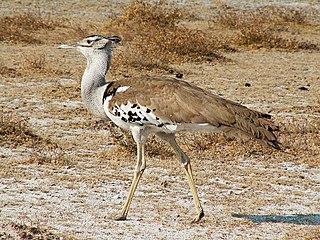
The kori bustard is the largest flying bird native to Africa. It is a member of the bustard family, which all belong to the order Otidiformes and are restricted in distribution to the Old World. It is one of the four species in the large-bodied genus Ardeotis. In fact, the male kori bustard may be the heaviest living animal capable of flight.

The yellow-legged buttonquail is a buttonquail, one of a small family of birds which resemble, but are unrelated to, the true quails. This family is peculiar in that the females are larger and more colourful than the males and are polyandrous.

The chestnut-bellied sandgrouse or common sandgrouse is a species of sandgrouse. It is a sedentary and nomadic species that ranges from northern and central Africa and further east towards western and southern Asia. There are six recognised subspecies.
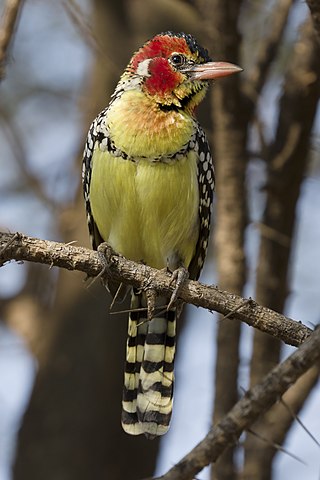
The red-and-yellow barbet is a species of African barbet found in eastern Africa. Males have distinctive black, red, and yellow plumage; females and juveniles are similar, but less brightly colored. The species lives in broken terrain and nests and roosts in burrows. Omnivorous, the species feeds on seeds, fruit, and invertebrates. Where not hunted, they are tame, but their feathers are used by certain tribes, such as the Maasai.
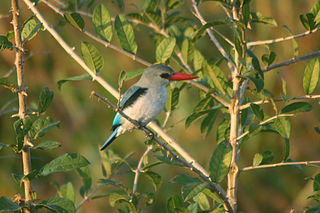
The mangrove kingfisher is a kingfisher in the genus Halcyon. It is similar in appearance to the woodland kingfisher. It is found along the eastern coastline of Sub-Saharan Africa, living in woodland, along rivers, and in estuaries and mangrove. The International Union for Conservation of Nature (IUCN) has assessed it as being of least concern.
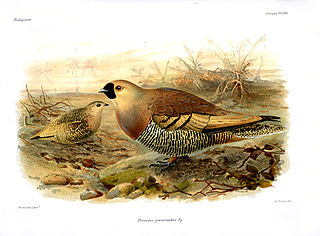
The Madagascar sandgrouse is a species of bird in the family Pteroclidae. It is endemic to Madagascar and is a ground-dwelling short-legged plump bird. The head of the male is brown with a black area surrounding the beak. It has a pinkish-buff coloured breast, a light brown mottled back, brown wings and paler underparts barred with dark brown. The female has a generally duller appearance being cryptically coloured brown with dark specks and bars.

The northern black korhaan, also known as the white-quilled bustard, is a species of bird in the bustard family, Otididae. It is widely distributed across Southern Africa. Its habitat is primarily open grassland and scrub.

The blue korhaan or blue bustard is a species of bird in the family Otididae which is native to South Africa. Its call is a series of frog-like croaks, usually uttered in flight. Its natural habitat is plateau grassland, dry shrubland, arable land and pastureland. Its preferred habitat is one with short grassland and flat topography.

The buff-crested bustard is a medium-sized bird of East Africa; Somalia, Ethiopia, Kenya belonging to the family Otididae. The populations are stable and the species is of least concern.
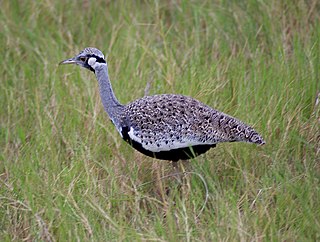
Hartlaub's bustard is a species of bird in the family Otididae. It is a medium-sized bustard with a long, think neck, and long legs. It is found in open, tall grassland, range from 1600 meters to 2000 meters in Ethiopia, Kenya, Somalia, Sudan, Tanzania, and Uganda.
The little brown bustard is a species of bird in the family Otididae. Found in Ethiopia and Somalia, its natural habitats are subtropical or tropical dry shrubland and subtropical or tropical dry lowland grassland. As indicated by its name, this bustard is the world's smallest at 45 cm (18 in) and 600 grams (1.3 lb). It is threatened by habitat destruction.
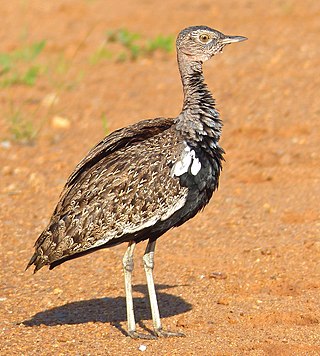
The red-crested korhaan or red-crested bustard is a species of bird in the family Otididae. It is found in Angola, Botswana, Eswatini, Mozambique, Namibia, South Africa, Zambia, and Zimbabwe.
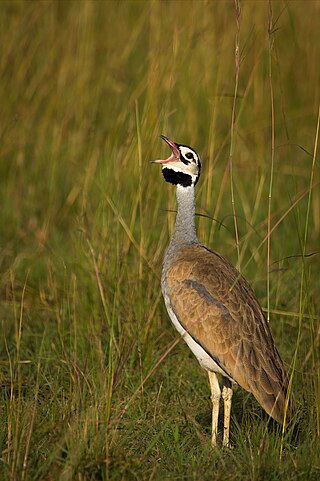
The white-bellied bustard or white-bellied korhaan is an African species of bustard. It is widespread in sub-Saharan Africa in grassland and open woodland habitats. Despite its wide distribution and easily identifiable characteristics, very few studies have been conducted on this species and little is known about its life history and behavior.
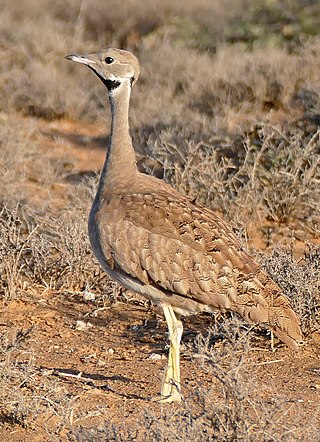
The karoo korhaan, also known as karoo bustard, is a species of bird in the bustard family, Otididae, from Southern Africa. There are two subspecies, the nominate race, from south-eastern South Africa, and H. v. namaqua, from north-western South Africa and southern Namibia.

The bearded scrub robin, also known as the eastern bearded scrub robin, is a species of bird in the family Muscicapidae. It is found in eastern and southern Africa.

The white-bellied piculet is a Vulnerable species of bird in subfamily Picumninae of the woodpecker family Picidae. It is found in Brazil, Guyana, and Venezuela.

The black-fronted bushshrike is a passerine bird of the bushshrike family, Malaconotidae. It inhabits forests mainly in East Africa. It forms a superspecies with the many-colored bushshrike and the two are sometimes considered to be a single species.

The Abyssinian wheatear, or Abyssinian black wheatear, is a species of bird in the family Muscicapidae, the Old World flycatchers and chats. It is found from Ethiopia to southern Kenya and north-eastern Tanzania.

The yellow-crowned bishop is a species of passerine bird in the family Ploceidae native to Africa south of the Sahara. It is highly sexually dimorphic in its breeding season, during which the male adopts a distinctive yellow and black plumage, contrasting with the female's predominantly brown coloration. Four subspecies are recognised.






















